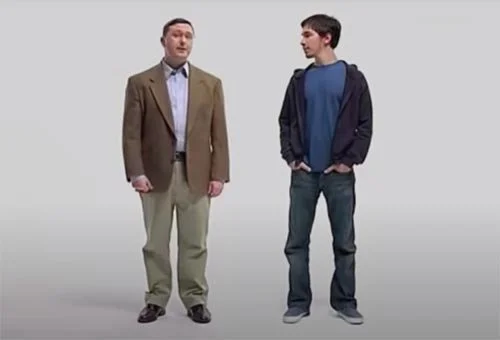NOTES
Brand myths & legends: Jobs, Ford & Apple
If you were asked to name a truly legendary brand, Apple may well come to mind. How much of that legend is clever brand-building? How much is myth? And does the difference matter?
by Joe Grossmann · 6.5 min read
illustrations by Matt Johnson
Those of us who follow success stories in business are often drawn to cases involving so-called visionaries. You know the type: an innovator and brand leader, usually quirky or charismatic, who sees a future the rest of us might find a bit far-fetched.
Visionaries lead with the courage of their convictions, often discounting the opinions or expertise of others. Perhaps the most obvious example is Steve Jobs, the cofounder of Apple and its on-again, off-again CEO, who was infamous for his self-assuredness as well as his prickly nature.
In addition to building one of the world’s largest and most consistently innovative companies, Jobs inspired nine documentaries, four movies, and two dozen books. While many will remember him as a technology innovator, it was actually his track record in brand strategy and marketing that is most interesting.
Perhaps most famously, in a 1998 BusinessWeek interview, Jobs implied that he knew what people wanted well before they did, and that market research had little or no role in product development:
“It’s really hard to design products by focus groups. A lot of times, people don’t know what they want until you show it to them.”
Fans of Steve Jobs—as well as critics of focus group methodologies—love this quotation. In their interpretation, Jobs pointed out the obvious: if we market tested every innovative idea by seeking approval from a group of presumably unimaginative consumers, we’d all still be stuck in the Middle Ages.
Jobs later reinforced this viewpoint when he told Walter Isaacson, his biographer,
“Some people say, ‘Give the customers what they want.’ But that’s not my approach. Our job is to figure out what they’re going to want before they do. I think Henry Ford once said, ‘If I’d asked customers what they wanted, they would have told me, “A faster horse!”’”
A great quote within a quote, right? In just under 50 words, Jobs perpetuated the legend of his own genius and prescience while positioning himself as a successor to the equally legendary Henry Ford.
As it turns out, there’s actually no evidence that Ford said this or anything similar. (The quote appears to have been proposed hypothetically in 1999 by John McNeece, a cruise ship designer, then later repeated as fact by others, including Jobs.)
The reality distortion field
Of course, whether Ford said this or not was immaterial. Jobs was always inventing the reality he desired, and it usually worked. Inside Apple, his ability to bend facts to pursue his goals was deemed the “reality distortion field,” explained here by Andy Hertzfeld (designer of the original Macintosh operating system), who joined Apple in 1979:
“In his presence, reality is malleable. He can convince anyone of practically anything. It wears off when he’s not around, but it makes it hard to have realistic schedules.…just because he tells you that something is awful or great, it doesn’t necessarily mean he’ll feel that way tomorrow.…If you tell him a new idea, he’ll usually tell you that he thinks it’s stupid. But then, if he actually likes it, exactly one week later, he’ll come back to you and propose your idea to you, as if he thought of it.”
The reality distortion field even came into play with regard to the Ford quote. A few others had repeated the apocryphal quote before Jobs, including his friend Tom Kelley (founder of Apple’s industrial design firm, IDEO), but Jobs can probably take credit for popularizing the quote while simultaneously linking it to his own legacy.
Crazy ones
Why have these quotes by Jobs garnered so much attention and fandom in the first place?
Perhaps it’s because these anecdotes romanticize the courage and ingenuity of brand leaders and innovators. We like the idea of visionaries and rebels. In fact, Steve Jobs doubled down on that theme in 1997 with the “Think Different” ad campaign, soon after he returned to Apple to save it from a precipitous slide during the price wars of the mid-’90s.
The centerpiece of the campaign was a groundbreaking television ad, known internally as “Crazy Ones”:
“Here’s to the crazy ones. The misfits. The rebels. The troublemakers. The round pegs in the square holes. The ones who see things differently. They’re not fond of rules. And they have no respect for the status quo. You can quote them, disagree with them, glorify or vilify them. About the only thing you can’t do is ignore them. Because they change things. They push the human race forward. And while some may see them as the crazy ones, we see genius. Because the people who are crazy enough to think they can change the world, are the ones who do.”
The “Think Different” campaign was wildly successful, instantly repositioning Apple as a champion of creative types, misunderstood and undervalued by the business world, yet destined to change our future.
It was also a win for Steve Jobs’s personal brand, since he was depicted as a visionary savior, returning to save his prodigal child.
The creative concept for the campaign has been widely attributed to Jobs, further burnishing his reputation for branding genius. While it’s not disputed that Jobs threw his full support behind the campaign, he was initially hesitant to run with the concept, according to one of the campaign’s authors at TBWA/Chiat/Day. (Ironically, as has been reported by this creative director and many other creatives he employed, Jobs was extremely difficult, frequently belittling or dismissing their many efforts to please him.)
Circling back: is it really true Apple didn’t use market research?
We began this story by exploring Jobs’s 1998 suggestion that Apple didn’t use focus groups in the course of product development. Was that true? And did he really mean to imply that Apple simply never used market research?
In 2008, Jobs told Fortune:
“We do no market research. We don’t hire consultants. The only consultants I’ve ever hired in my 10 years is one firm to analyze Gateway’s retail strategy so I would not make some of the same mistakes they made [when launching Apple’s retail stores]. But we never hire consultants, per se. We just want to make great products.”
That’s a bold statement and a bit difficult to believe—especially considering Apple had $24 billion in sales by that point. As it turns out, this may have been another instance of his reality distortion field.
Jobs was in fact deeply interested in his target audience. It’s worth noting that two sentences are routinely omitted from citations of his 1998 “focus groups” quotation:
“We have a lot of customers, and we have a lot of research into our installed base. We also watch industry trends pretty carefully.”
In 2011, Apple brought a case against Samsung alleging infringement of Apple’s patents and copyrights. Apple won, but the case also surfaced evidence that Apple routinely utilized various forms of market research. Apple routinely conducted surveys, often using outside market research firms (as evidenced by this archived apple.com page from January 2006), and had even created an online focus group panel called Apple Customer Pulse.
Splitting hairs?
The fact is that Apple relied heavily on both user testing and market testing, including many forms of both qualitative and quantitative research. The company just liked to keep their research a secret—both to burnish the visionary dimension of the brand and to prevent competitors from discovering how the sausage was made.
While Jobs may have overstated his aversion to market research, he was probably not wholly disingenuous about its role in product development. Perhaps it’s true that Jobs never employed market research consultants to decide whether Apple should develop a novel product.
Jobs clearly considered human needs, perceptions, and behavioral patterns to be critical inputs for the development of the product concept itself. After all, Apple was an early pioneer in user interface design and user experience testing—a form of audience research.
Instead of asking a focus group whether they wanted something they had never seen, he focused on creating products that offered people new experiences and capabilities. Development at Apple under Jobs was driven primarily by recognition of essential human needs combined with insights from user testing rather than desires explicitly stated in focus groups or questionnaires. Once Apple products entered the marketplace, people could try them out, then embrace or reject them. And that’s when the market research kicked in.
Jobs was a very keen observer and listener, and he was right: people didn’t know they wanted an Apple product until they tried it. By taking these risks and monitoring customer responses, Jobs played the long game—and Apple eventually won.
What was Steve Jobs’s greatest brand insight?
He knew that a significant percentage of people would adopt technology if it made them feel more adventurous, creative, or fun, rather than simply more productive. Apple customers bonded by “being in” on the revolution, forming their own fan culture and reinforcing the brand. That’s why the “Think Different” campaign touched a nerve, as well as the later effort to further define tribal affinities with the “Get a Mac” campaign of 66 commercials that ran from 2006 to 2009.
He also discovered early in his career, perhaps during his time in the Homebrew Computer Club, that he could easily inspire people by exhibiting the kind of single-minded focus and supreme confidence others around him lacked. He continued testing and refining those leadership skills during the early years of Apple, eventually perfecting his cult of personality, both in internal meetings at Apple headquarters and later on stage during his extravagant product introductions.
The legacy of Jobs’s brand leadership
Walter Isaacson summarized the key elements of Jobs’s unique leadership style for the Harvard Business Review, boiling it down to fourteen core principles. Of those, the following eight may offer the most inspiration to leaders working to transform their brands:
Focus
Simplify
Take responsibility end to end
When behind, leapfrog
Bend reality
Push for perfection
Engage face-to-face
Know both the big picture and the details
As any leader knows, those are easier said than done—at least, consistently and effectively.
Even if you’re not a fan of Apple or a devotee of Steve Jobs, you can learn quite a bit about brand strategy and leadership (as well as some less desirable character traits of ambitious leaders) by studying his extraordinary 35-year run at the helms of Apple, Next, and Pixar.
Even when his technology gambles fell short, his seemingly inexhaustible chutzpah and commitment to building a compelling brand never wavered.









